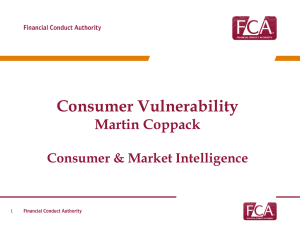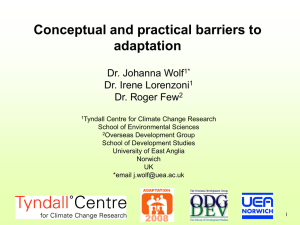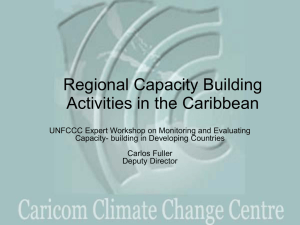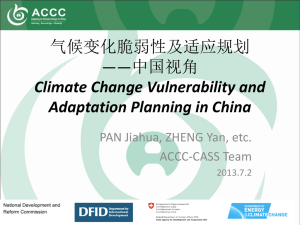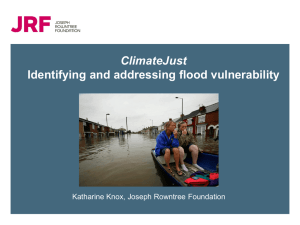Social Vulnerability
advertisement
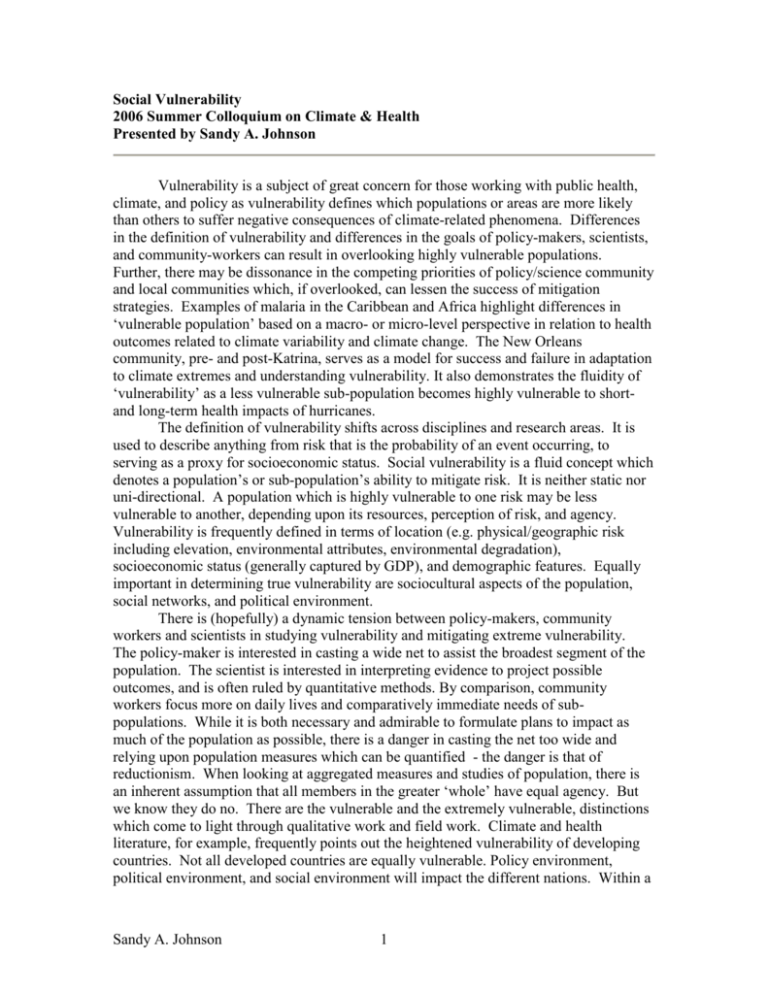
Social Vulnerability 2006 Summer Colloquium on Climate & Health Presented by Sandy A. Johnson Vulnerability is a subject of great concern for those working with public health, climate, and policy as vulnerability defines which populations or areas are more likely than others to suffer negative consequences of climate-related phenomena. Differences in the definition of vulnerability and differences in the goals of policy-makers, scientists, and community-workers can result in overlooking highly vulnerable populations. Further, there may be dissonance in the competing priorities of policy/science community and local communities which, if overlooked, can lessen the success of mitigation strategies. Examples of malaria in the Caribbean and Africa highlight differences in ‘vulnerable population’ based on a macro- or micro-level perspective in relation to health outcomes related to climate variability and climate change. The New Orleans community, pre- and post-Katrina, serves as a model for success and failure in adaptation to climate extremes and understanding vulnerability. It also demonstrates the fluidity of ‘vulnerability’ as a less vulnerable sub-population becomes highly vulnerable to shortand long-term health impacts of hurricanes. The definition of vulnerability shifts across disciplines and research areas. It is used to describe anything from risk that is the probability of an event occurring, to serving as a proxy for socioeconomic status. Social vulnerability is a fluid concept which denotes a population’s or sub-population’s ability to mitigate risk. It is neither static nor uni-directional. A population which is highly vulnerable to one risk may be less vulnerable to another, depending upon its resources, perception of risk, and agency. Vulnerability is frequently defined in terms of location (e.g. physical/geographic risk including elevation, environmental attributes, environmental degradation), socioeconomic status (generally captured by GDP), and demographic features. Equally important in determining true vulnerability are sociocultural aspects of the population, social networks, and political environment. There is (hopefully) a dynamic tension between policy-makers, community workers and scientists in studying vulnerability and mitigating extreme vulnerability. The policy-maker is interested in casting a wide net to assist the broadest segment of the population. The scientist is interested in interpreting evidence to project possible outcomes, and is often ruled by quantitative methods. By comparison, community workers focus more on daily lives and comparatively immediate needs of subpopulations. While it is both necessary and admirable to formulate plans to impact as much of the population as possible, there is a danger in casting the net too wide and relying upon population measures which can be quantified - the danger is that of reductionism. When looking at aggregated measures and studies of population, there is an inherent assumption that all members in the greater ‘whole’ have equal agency. But we know they do no. There are the vulnerable and the extremely vulnerable, distinctions which come to light through qualitative work and field work. Climate and health literature, for example, frequently points out the heightened vulnerability of developing countries. Not all developed countries are equally vulnerable. Policy environment, political environment, and social environment will impact the different nations. Within a Sandy A. Johnson 1 single nation, sub-populations will have varying degrees of vulnerability often determined by empowerment. Successfully planning to address social vulnerability must take into account the needs of the many as well as plan to assist those who most need it. Understanding vulnerability alone will not lead to successful adaptation and mitigation. The science and policy communities are rarified environments which allow for a focus on a single issue. By working with that particular issue every day, scientists understand its relative import. The average person in any given community does not live in such a focused environment. She is caught up in the ‘everyday struggle to survive.’ What to the scientist or public health worker appears to be simple and appropriate behavioral change to stave off catastrophe may make little sense in this person’s daily existence. Or, even is such change made sense, she may have priorities which whittle away her energy and resources, leaving nothing left over with which to make the desired adaptation. Understanding social vulnerability entails understanding what these competing needs are and translating them into adaptation and mitigation plans. Social vulnerability itself is not static. Changes in the political economy, natural environment, and social fabric will create change in the vulnerabilities of subpopulations. Sometime the changes are short-term and local responses are most appropriate. Other times, however, the paradigm guiding policy and more extensive efforts for adaptation and mitigation must be adapted to address issues within the altered landscape. Malaria presents one example of a health risk with hidden pockets of vulnerability and a malleable landscape. Malaria is considered a health problem in two provinces of the Dominican Republic. However, vulnerability to this disease varies according to social position of individuals and economic development timelines in local communities. Climate variability appears to be a small factor in malaria cases. Other health and welfare issues are of greater concern and could inform adaptive responses. Hurricane Katrina provides examples of success and failures in understanding social vulnerability, planning to mitigate health outcomes, and responding to an extreme event. Staggering death tolls, however, showed that the system is not infallible and failed to identify specific vulnerable groups. However, the mortality profile was not necessarily what one would have expected based on other experience with floods. This emphasizes the importance of local context in understanding social vulnerability. The comparatively successful evacuation proved the utility of adaptation and early warning systems. The evacuation and short- and long-term responses, however, have also demonstrated that local knowledge of vulnerability can be more reliable and successful at providing for the most vulnerable than state or national responses. Vulnerabilities in this current hurricane season have changed as a result of the dramatically altered physical and social environment in New Orleans. New resiliencies have been introduced, but subpopulations not previously considered highly vulnerable to hurricane-related health sequelae are now in a precarious position. Longer term vulnerabilities remain unclear in the changing socioeconomic situation. Sandy A. Johnson 2



